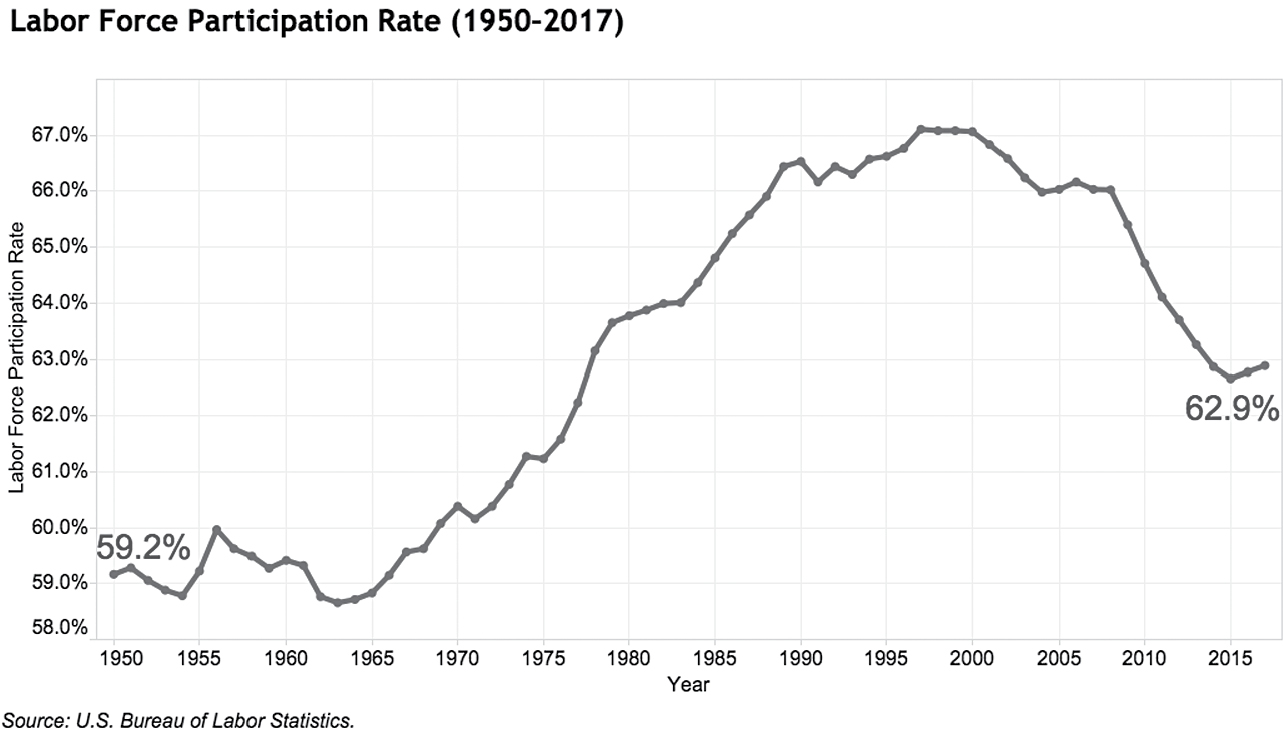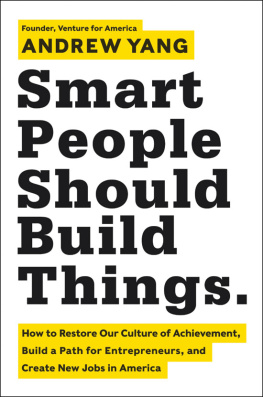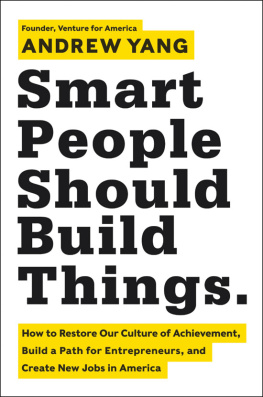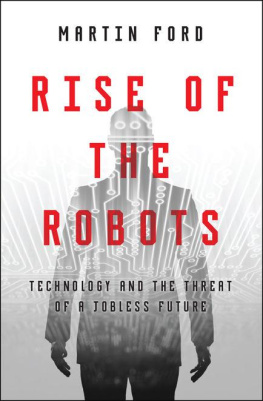Thank you for buying this ebook, published by Hachette Digital.
To receive special offers, bonus content, and news about our latest ebooks and apps, sign up for our newsletters.
Copyright 2018 by Andrew Yang
Jacket design by Amanda Kain
Jacket photograph Jette Productions/Getty Images
Cover copyright 2018 by Hachette Book Group, Inc.
Hachette Book Group supports the right to free expression and the value of copyright. The purpose of copyright is to encourage writers and artists to produce the creative works that enrich our culture.
The scanning, uploading, and distribution of this book without permission is a theft of the authors intellectual property. If you would like permission to use material from the book (other than for review purposes), please contact permissions@hbgusa.com. Thank you for your support of the authors rights.
Hachette Books
Hachette Book Group
1290 Avenue of the Americas
New York, NY 10104
hachettebooks.com
twitter.com/hachettebooks
First Edition: April 2018
Hachette Books is a division of Hachette Book Group, Inc.
The Hachette Books name and logo are trademarks of Hachette Book Group, Inc.
The publisher is not responsible for websites (or their content) that are not owned by the publisher.
The Hachette Speakers Bureau provides a wide range of authors for speaking events. To find out more, go to www.hachettespeakersbureau.com or call (866) 376-6591.
Library of Congress Control Number: 2017918606
ISBNs: 978-0-316-41424-1 (hardcover), 978-0-316-41425-8 (ebook)
E3-20180219-JV-NF
To everyone who helped build Venture for America over the years. You made me believe in people.
We are at the most dangerous moment in the development of humanity the rise of artificial intelligence is likely to extend job destruction deep into the middle classes, with only the most caring, creative or supervisory roles remaining.
S TEPHEN H AWKING
Human beings are also animals, to manage one million animals gives me a headache.
T ERRY G OU , FOUNDER OF F OXCONN
I am writing from inside the tech bubble to let you know that we are coming for your jobs.
I recently met a pair of old friends for drinks in Manhattan. One is an executive who works at a software company in New York. They replace call center workers with artificial intelligence software. I asked her whether she believed her work would result in job losses. She responded matter-of-factly, We are getting better and better at things that will make large numbers of workers extraneous. And we will succeed. There needs to be a dramatic reskilling of the workforce, but thats not going to be practical for a lot of people. Its impossible to avoid a lost generation of workers. Her confidence in this assessment was total. The conversation then quickly shifted to more pleasant topics.
I later met with a friend whos a Boston-based venture capitalist. He told me he felt a little uneasy about investing in software and robotics companies that, if successful, would eliminate large numbers of jobs. But theyre good opportunities, he noted, estimating that 70 percent of the startups hes seeing will contribute to job losses in other parts of the economy.
In San Francisco, I had breakfast with an operations manager for a large tech company. He told me, I just helped set up a factory that had 70 percent fewer workers than one even a few years ago would have had, and most of them are high-end technicians on laptops. I have no idea what normal people are going to do in a few years.
Normal people. Seventy percent of Americans consider themselves part of the middle class. Chances are, you do, too. Right now some of the smartest people in the country are trying to figure out how to replace you with an overseas worker, a cheaper version of you, or, increasingly, a widget, software program, or robot. Theres no malice in it. The market rewards business leaders for making things more efficient. Efficiency doesnt love normal people. It loves getting things done in the most cost-effective way possible.
A wave of automation and job loss is no longer a dystopian vision of the futureits well under way. The numbers have been telling a story for a while now that we have been ignoring. More and more people of prime working age have been dropping out of the workforce. Theres a growing mass of the permanently displaced. Automation is accelerating to a point where it will soon threaten our social fabric and way of life.
Experts and researchers project an unprecedented wave of job destruction coming with the development of artificial intelligence, robotics, software, and automation. The Obama White House published a report in December 2016 that predicted 83 percent of jobs where people make less than $20 per hour will be subject to automation or replacement. Between 2.2 and 3.1 million car, bus, and truck driving jobs in the United States will be eliminated by the advent of self-driving vehicles.
Read that last sentence again: we are confident that between 2 and 3 million Americans who drive vehicles for a living will lose their jobs in the next 10 to 15 years. Driving a truck is the most common occupation in 29 states. Self-driving vehicles are one of the most obvious job-destroying technologies, but there are similar innovations ahead that will displace cashiers, fast food workers, customer service representatives, administrative assistants, and even well-paid white-collar jobs like wealth managers, lawyers, and insurance agents, all within the span of a few short years. Suddenly out of work, millions will struggle to find a new job, particularly those at the lower end of the skill ladder.
Automation has already eliminated about 4 million manufacturing jobs in the United States since 2000. Instead of finding new jobs, a lot of those people left the workforce and didnt come back. The U.S. labor force participation rate is now at only 62.9 percent, a rate below that of nearly all other industrialized economies and about the same as that of El Salvador and the Ukraine. Some of this is driven by an aging population, which presents its own set of problems, but much of it is driven by automation and a lower demand for labor.
Each 1 percent decline in the labor participation rate equates to approximately 2.5 million Americans dropping out. The number of working-age Americans who arent in the workforce has surged to a record 95 million. Ten years into the nations recovery from the financial crisis and 95 million working-age Americans not in the workforceIve taken to calling this phenomenon the Great Displacement.

The lack of mobility and growth has created a breeding ground for political hostility and social ills. High rates of unemployment and underemployment are linked to an array of social problems, including substance abuse, domestic violence, child abuse, and depression. Today 40 percent of American children are born outside of married households, due in large part to the crumbling marriage rate among working-class adults, and overdoses and suicides have overtaken auto accidents as leading causes of death. More than half of American households already rely on the government for direct income in some form. In some parts of the United States, 20 percent of working-age adults are now on disability, with increasing numbers citing mood disorders. What Americans who cannot find jobs find instead is despair. If you care about communities and our way of life, you care about people having jobs.









